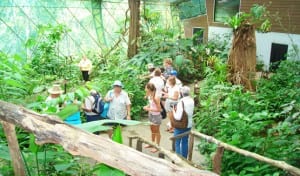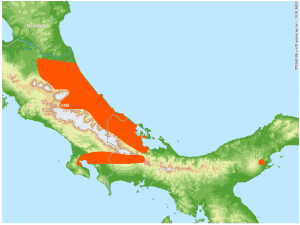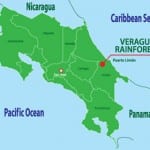What if I told you there was an animal without lungs that lives on land and can grow back any limb of its body?
Crazy, you say? Well, in the Costa Rican Caribbean rainforest, there is a species of salamander that can.
 Salamanders are amphibians that are typically characterized by a lizard-like appearance, with slender bodies, short noses, and long tails, according to Wikipedia. There are approximately 550 species of salamanders that live in Temperate and Neotropical zones around the world.
Salamanders are amphibians that are typically characterized by a lizard-like appearance, with slender bodies, short noses, and long tails, according to Wikipedia. There are approximately 550 species of salamanders that live in Temperate and Neotropical zones around the world.
Unique among vertebrates, salamanders are capable of regenerating lost limbs. For instance, they often lose their tail when attacked in order to escape quickly and distract their predator. Within only a few weeks of losing a piece of limb, a salamander perfectly reforms the missing segment, notes Wikipedia.
Salamanders’ limb regeneration has been the focus of significant interest among scientists, because they are considered the epitome of perfect regeneration. Researchers have been trying to find out the conditions required for regeneration to be able to duplicate the process with humans.
 The salamanders that inhabit Costa Rica also have no lungs, so their respiration occurs through their delicate skin and the tissues lining their mouths. Their moist skin usually makes salamanders reliant on habitats in or near water, or in moist ground such as in the rainforest.
The salamanders that inhabit Costa Rica also have no lungs, so their respiration occurs through their delicate skin and the tissues lining their mouths. Their moist skin usually makes salamanders reliant on habitats in or near water, or in moist ground such as in the rainforest.
At Veragua Rainforest in Costa Rica’s Caribbean area, there is an abundance of salamanders. The diversity of amphibians and reptiles of Costa Rica’s Central Caribbean had been little studied until the University of Costa Rica and Veragua Rainforest’s biologists began investigating the region.
 Veragua Rainforest is a 1,300 hectare (3,212 acre) biology research site and adventure center, located about an hour inland from the Caribbean Coast and the port town of Limón. It is an area of dense tropical rainforest in the foothills of the Talamanca Mountains bordering the La Amistad (“Friendship”) International Park, the country’s largest and most remote national park that is shared by Costa Rica and Panama. Veragua’s biologists partner with the University of Costa Rica (UCR), the National Institute of Biodiversity (INBio), and the National Museum of Natural History to preserve the area’s population of frogs, snakes, lizards, iguanas, insects, butterflies and birds.
Veragua Rainforest is a 1,300 hectare (3,212 acre) biology research site and adventure center, located about an hour inland from the Caribbean Coast and the port town of Limón. It is an area of dense tropical rainforest in the foothills of the Talamanca Mountains bordering the La Amistad (“Friendship”) International Park, the country’s largest and most remote national park that is shared by Costa Rica and Panama. Veragua’s biologists partner with the University of Costa Rica (UCR), the National Institute of Biodiversity (INBio), and the National Museum of Natural History to preserve the area’s population of frogs, snakes, lizards, iguanas, insects, butterflies and birds.
 The most popular salamander at Veragua Rainforest is the La Loma Salamander, or Tropical Climbing Salamander (Bolitoglossa colonnea), a species of lungless salamander found in Costa Rica and Panama, reports resident biologist Wagner Chaves. The La Loma Salamanders are native to the Western Hemisphere, from British Columbia to Brazil. The species is threatened by habitat loss – tropical moist lowland and tropical montane forests.
The most popular salamander at Veragua Rainforest is the La Loma Salamander, or Tropical Climbing Salamander (Bolitoglossa colonnea), a species of lungless salamander found in Costa Rica and Panama, reports resident biologist Wagner Chaves. The La Loma Salamanders are native to the Western Hemisphere, from British Columbia to Brazil. The species is threatened by habitat loss – tropical moist lowland and tropical montane forests.
Veragua Rainforest Research & Adventure
 Veragua Rainforest offers an excellent educational opportunity for students and educators with hands-on research of rainforest life. The park is not-to-be-missed when visiting Costa Rica’s Caribbean area. The property contains a biology research station, wildlife habitats, rainforest walking trails, a river and waterfall, an aerial tramway, a canopy zip line tour, student group accommodations, and a restaurant, café and souvenir shop. The Park is open to day visitors Tuesday to Sunday, from 8:00 am to 3:00 pm.
Veragua Rainforest offers an excellent educational opportunity for students and educators with hands-on research of rainforest life. The park is not-to-be-missed when visiting Costa Rica’s Caribbean area. The property contains a biology research station, wildlife habitats, rainforest walking trails, a river and waterfall, an aerial tramway, a canopy zip line tour, student group accommodations, and a restaurant, café and souvenir shop. The Park is open to day visitors Tuesday to Sunday, from 8:00 am to 3:00 pm.
Comments
Thanks Rolando for taking the time to comment. I think Veragua is one of the best tours in Costa Rica's Caribbean area.
I have had the opportunity to visit Veragua, and it is truly above any expectation you may have about a rainforest. As a tip, it makes a great visit to your way to the Souther Caribbean (Puerto Viejo, Cocles, Manzanillo, etc), it is only about 30 min detour from the main road.